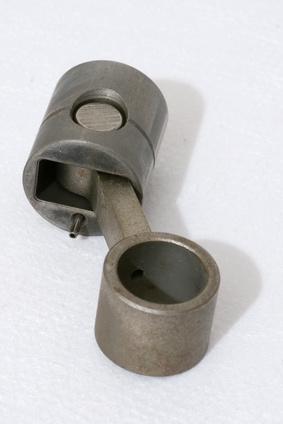
Small block Chevy engines that are being rebuilt go through a process of restoration. Restoring one of these motors involves disassembly, replacing worn or damaged parts and then reassembly. Install pistons in a small block Chevy after preparing for reassembly. When installed with new rings and bearings, the restored small block pistons will have no worn parts. They will pump out reliable power without problem and protect the cylinder walls during operation.
Apply a thin film of 10W-30 oil on the piston and connecting rod. Secure the piston in a table vice wrapped in a protective rag.
Wrap the piston head with an oil ring so it sits inside the bottom ring groove of the piston head when in position. All the rings have a slot cut out of them so the circular rings can be twisted to fit around the piston head and sit inside the bottom groove of the piston head.
Insert one end of the next ring, a compression ring into the groove of the second ring seat located in between the top groove and the oil ring installed in the bottom ring location. Pull up on the other end of the piston ring and pull it over the top of the piston head. This will cause the piston ring to wrap around the piston head and fall into place within the second grove of the piston head.
Insert the third and last piston ring in the top groove of the piston head. Insert one end into the groove and pull the loose end over the top of the piston so the ring wraps the piston and can be manipulated with your fingers into place in the top groove.
Align the slots in each of the rings so that one slot is not directly above or below another piston ring slot. These slots allow fluids and gas to pass through the rings but the passage should not extend through more than one piston ring.
Tighten a piston ring compressor around the piston head and rings. The compressed piston assembly will fit into the cylinder bore once the new compression rings are squeezed tightly around the piston.
Push a piston into a cylinder starting from the bottom up. Place the end of the connecting rod into the cylinder bore from the top. Feed the piston into the bore hole until the piston ring compressor sits on top of the engine, preventing the piston from falling into place.
Tap the top of the piston with a soft mallet. The tapping will push the piston out of the piston ring compressor and into the cylinder bore. Oil the area where the piston connecting rod with be tightened to the crankshaft journal. Insert new connecting rod bearings around the crankshaft journal and snug the piston in place without tightening completely.
Insert the next piston in the next cylinder so that the two pistons pair up at the crankshaft. Both bearing assemblies and end caps of these two pistons will work side-by-side during operation of the engine. Tighten the bearing cap bolts completely after both pistons are installed.
Turn the crankshaft so that the next pair of pistons can be installed just like the first pair until all are installed. Oil each assembly and the critical junctions where moving parts meet.